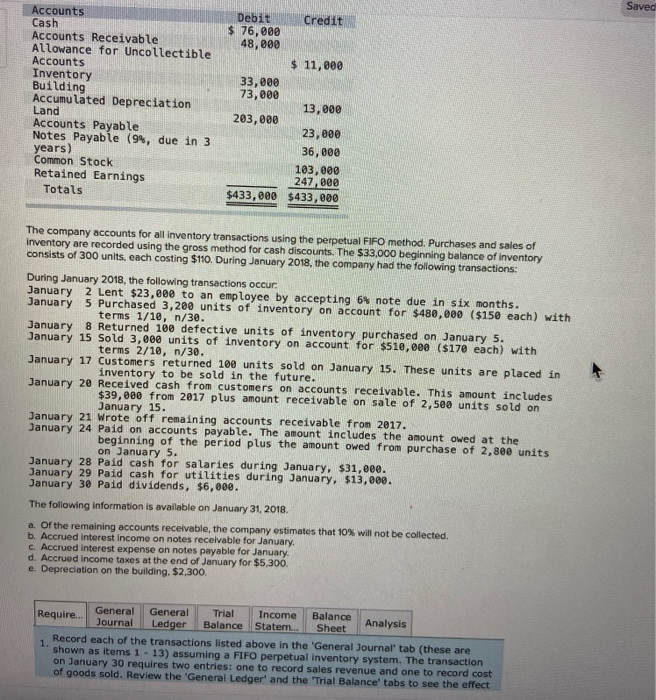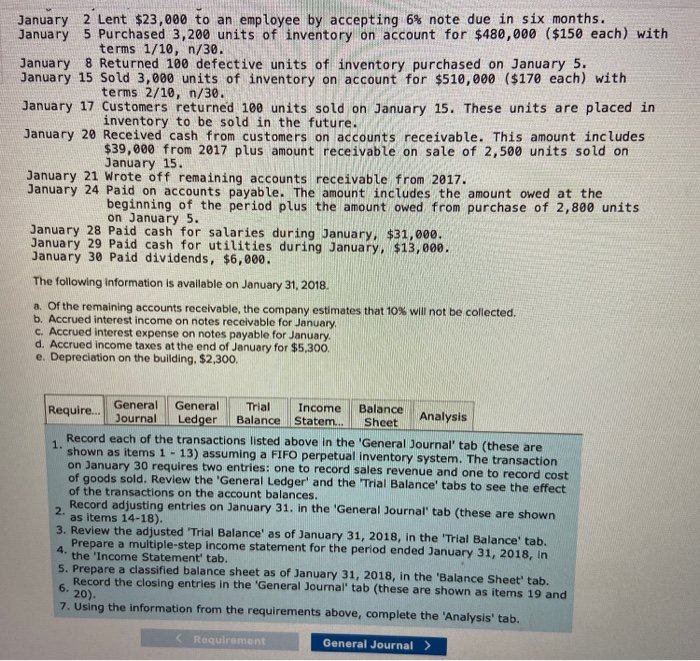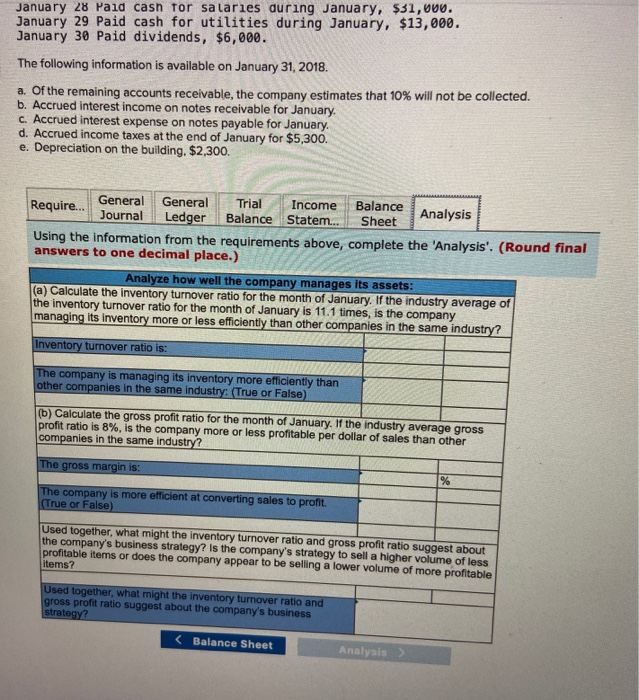Answered step by step
Verified Expert Solution
Question
1 Approved Answer
on january 1, 2018 the general ledger of a company includes the following account balances Accounts Cash Accounts Receivable Allowance for Uncollectible Accounts Inventory Building
on january 1, 2018 the general ledger of a company includes the following account balances 


Accounts Cash Accounts Receivable Allowance for Uncollectible Accounts Inventory Building Accumulated Depreciation Land Accounts Payable Notes Payable (9%, due in 3 years) Common Stock Retained Earnings Totals Debit Credit $ 76,000 48,000 $ 11,000 33,000 73,000 13,000 203,000 23,000 36,000 103,000 247,000 $433,000 $433,000 The company accounts for all inventory transactions using the perpetual FIFO method. Purchases and sales of Inventory are recorded using the gross method for cash discounts. The $33,000 beginning balance of inventory consists of 300 units, each costing $110. During January 2018, the company had the following transactions: During January 2018, the following transactions occur. January 2 Lent $23,000 to an employee by accepting 6 note due in six months. January 5 Purchased 3,200 units of inventory on account for $480,000 ($150 each) with terms 1/10, n/30. January 8 Returned 100 defective units of inventory purchased on January 5. January 15 Sold 3,000 units of inventory on account for $510,000 ($170 each) with terms 2/10, n/30. January 17 Customers returned 100 units sold on January 15. These units are placed in inventory to be sold in the future. January 20 Received cash from customers on accounts receivable. This amount includes $39,000 from 2017 plus amount receivable on sale of 2,500 units sold on January 15. January 21 Wrote off remaining accounts receivable from 2017. January 24 Paid on accounts payable. The amount includes the amount owed at the beginning of the period plus the amount owed from purchase of 2,800 units on January 5. January 28 Paid cash for salaries during January, $31, eee. January 29 Paid cash for utilities during January, $13,000. January 30 Paid dividends, $6,000. The following information is available on January 31, 2018 a. Of the remaining accounts receivable, the company estimates that 10% will not be collected. b. Accrued interest income on notes receivable for January c. Accrued interest expense on notes payable for January d. Accrued income taxes at the end of January for $5,300. e. Depreciation on the building, $2,300 Require... General General Trial Income Balance Journal Ledger Analysis Balance Statem... Sheet Record each of the transactions listed above in the 'General Journal' tab (these are shown as items 1 - 13) assuming a FIFO perpetual inventory system. The transaction on January 30 requires two entries: one to record sales revenue and one to record cost of goods sold. Review the 'General Ledger and the Trial Balance' tabs to see the effect January 2 Lent $23,000 to an employee by accepting 6% note due in six months. January 5 Purchased 3,200 units of inventory on account for $480,000 ($150 each) with terms 1/10, n/30. January 8 Returned 100 defective units of inventory purchased on January 5. January 15 Sold 3,000 units of inventory on account for $510,000 ($170 each) with terms 2/10, 1/30. January 17 Customers returned 100 units sold on January 15. These units are placed in inventory to be sold in the future. January 20 Received cash from customers on accounts receivable. This amount includes $39,000 from 2017 plus amount receivable on sale of 2,500 units sold on January 15. January 21 Wrote off remaining accounts receivable from 2017. January 24 Paid on accounts payable. The amount includes the amount owed at the beginning of the period plus the amount owed from purchase of 2,800 units on January 5. January 28 Paid cash for salaries during January, $31,000. January 29 Paid cash for utilities during January, $13,000. January 30 Paid dividends, $6,000. The following information is available on January 31, 2018 a. Of the remaining accounts receivable, the company estimates that 10% will not be collected b. Accrued interest income on notes receivable for January, C. Accrued interest expense on notes payable for January d. Accrued income taxes at the end of January for $5,300. e. Depreciation on the building. $2,300. General General Require... Trial Income Balance A Journal Ledger Balance Statem... Analysis Sheet Record each of the transactions listed above in the 'General Journal' tab (these are shown as items 1 - 13) assuming a FIFO perpetual inventory system. The transaction on January 30 requires two entries: one to record sales revenue and one to record cost of goods sold. Review the 'General Ledger' and the Trial Balance' tabs to see the effect of the transactions on the account balances. Record adjusting entries on January 31. in the 'General Journal' tab (these are shown as items 14-18). 3. Review the adjusted 'Trial Balance' as of January 31, 2018, in the 'Trial Balance' tab. Prepare a multiple-step income statement for the period ended January 31, 2018, in " the 'Income Statement' tab. 5. Prepare a classified balance sheet as of January 31, 2018, in the Balance Sheet' tab. Record the closing entries in the 'General Journal' tab (these are shown as items 19 and 6. 20) 7. Using the information from the requirements above, complete the 'Analysis' tab. - Requirement General Journal > January 28 Paid cash for salaries during January, $31,000. January 29 Paid cash for utilities during January, $13,000. January 30 Paid dividends, $6,000. The following information is available on January 31, 2018. a. Of the remaining accounts receivable, the company estimates that 10% will not be collected. b. Accrued interest income on notes receivable for January C. Accrued interest expense on notes payable for January d. Accrued income taxes at the end of January for $5,300. e. Depreciation on the building. $2,300. Require... General General Trial Income Balance Analysis Analysis Journal Ledger Balance Statem... Sheet Using the information from the requirements above, complete the 'Analysis'. (Round final answers to one decimal place.) Analyze how well the company manages its assets: (a) Calculate the inventory turnover ratio for the month of January. If the industry average of the inventory turnover ratio for the month of January is 11.1 times, is the company managing its inventory more or less efficiently than other companies in the same industry? Inventory turnover ratio is: The company is managing its inventory more efficiently than other companies in the same industry: True or False) (b) Calculate the gross profit ratio for the month of January. If the industry average gross profit ratio is 8%, is the company more or less profitable per dollar of sales than other companies in the same industry? The gross margin is: The company is more efficient at converting sales to profit. (True or False) Used together, what might the inventory turnover ratio and gross profit ratio suggest about the company's business strategy? Is the company's strategy to sell a higher volume of less profitable items or does the company appear to be selling a lower volume of more profitable items? Used together, what might the inventory turnover ratio and gross profit ratio suggest about the company's business strategy? 


Step by Step Solution
There are 3 Steps involved in it
Step: 1

Get Instant Access to Expert-Tailored Solutions
See step-by-step solutions with expert insights and AI powered tools for academic success
Step: 2

Step: 3

Ace Your Homework with AI
Get the answers you need in no time with our AI-driven, step-by-step assistance
Get Started


